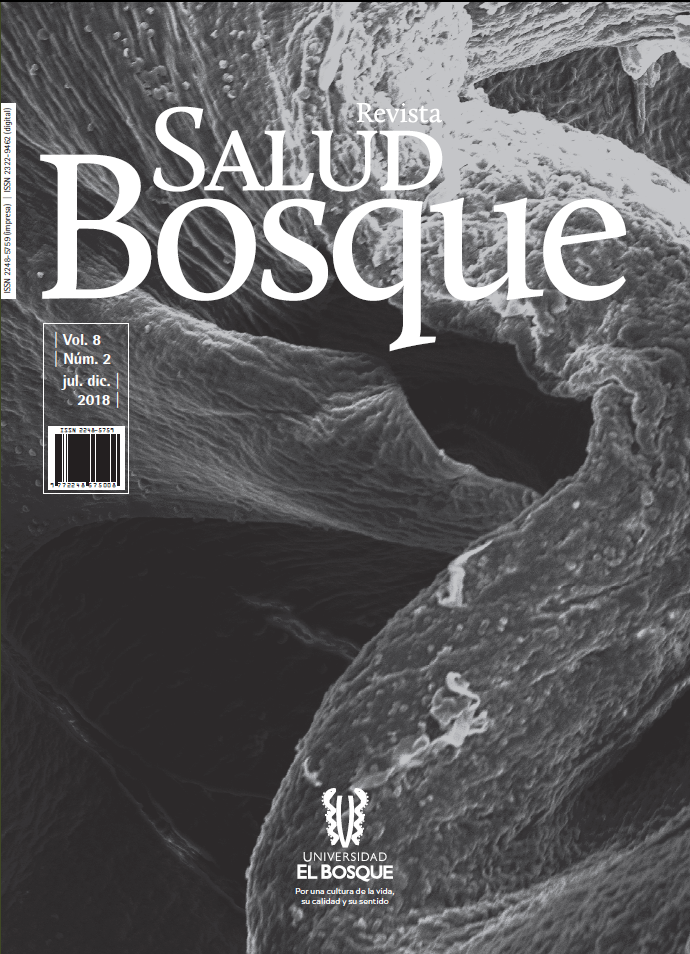Epigenómica social y conflicto armado: ¿por qué apostarle a la paz?
DOI:
https://doi.org/10.18270/rsb.v8i1.2494Palabras clave:
salud pública, Salud Pública, epigenética, Epigenética, guerra, Guerra, sumaq kawsay y suma qamaña, Sumaq Kawsay y suma qamañaResumen
El presente trabajo presenta un resumen de la evidencia científica que da cuenta de los efectos epigenéticos y la expresión fenotípica, de la expo- sición a ambientes de estrés crónico, propios de poblaciones expuestas al conflicto armado; considerando, además, las implicaciones potenciales para el logro de un buen vivir.
Materiales y métodos. Se hizo una revisión narrativa de la literatura cien- tífica de los últimos 10 años, en bases de datos Medline y Science Direct y repositorios de revistas como SciELO y BIREME. Se llevó a cabo un filtro inicial mediante títulos y resúmenes, de acuerdo con los criterios de inclu- sión y exclusión. Posteriormente, se hizo la lectura del texto completo en los artículos seleccionados.
Resultados. Se obtuvieron 33 artículos para lectura de texto completo. Entre los principales efectos documentados, se reportó la alteración de la expresión génica al estrés mediante activación neuronal (eje hipotála- mo-hipófiso-suprarrenal) con mayor sensibilidad a los glucocorticoides, conducente a estrés crónico y aumento de prevalencia de enfermedades crónicas no transmisibles.
Descargas
Referencias bibliográficas
Organización de Naciones Unidas. Declaración de los Derechos de los Pueblos Indígenas. Asia Pacific Forum como el ACNUDH 2013:1- 15.
Fernando Vega. El buen vivir-Sumak Kawsay en la Constitución y en el PNBV 2013-2017 del Ecuador. OBETS : Revista de Ciencias Sociales 2014 Jul 1,;9(1):167-194.
Macias A, Alonso P. El Buen Vivir. Sumak Kawsay, Una Oportunidad para Imaginar Otros Mundos. Revista de Economía Mundial (Magazine of World Economy (ies) 2013 Jan 1,(33):265-269.
FARC - Gobierno de Colombia. Acuerdo final para la terminación del conflicto y la construcción de una paz estable y duradera. 2016 Nov 24,:1-310.
Cole S, Lutgendorf S, Paige A Green, Nagaraja A. Sympathetic nervous system regulation of the tumour microenvironment. Nature Reviews. Cancer 2015 Sep 1,;15(9):563-572.
Krieger N. Epidemiology and the web of causation: Has anyone seen the spider? Social Science & Medicine 1994;39(7):887-903.
Krieger N. Chapter 7: Ecosocial theory of disease distribution. Epidemiology and the People’s Health US: Oxford University Press; 2011. p. 202-235.
Jablonka E. The evolutionary implications of epigenetic inheritance. Interface focus 2017 Oct 6,;7(5):20160135.
Jablonka E, Lamb MJ. Epigenetic inheritance in evolution. Journal of Evolutionary Biology 1998;11(2):159-183.
Li S, Dugué P, Hopper J, Milne R. Chapter 33: Epigenetic prospects in epidemiology and public health. In: Tollefsbol TO, editor. Epigenetics in Human Disease London: Academic Press; 2018. p. 995-1017.
Cole S.Social regulation of human gene expression:mechanisms and implications for public health. American journal of public health 2013 Oct;103 Suppl 1(S1):S92.
Moher D, Liberati A, Tetzlaff J, Altman DG. Preferred reporting items for systematic reviews and meta-analyses: the PRISMA statement. PLoS Med 2009 Jul 21,;6(7):e1000097.
von Elm E, Altman DG, Egger M, Pocock SJ, Gøtzsche PC, Vandenbroucke JP. The Strengthening the Reporting of Observational Studies in Epidemiology (STROBE) statement: guidelines for reporting observational studies. Lancet, The 2007;370(9596):1453-1457.
Deci E, Ryan R. Hedonia, eudaimonia, and well-being: an introduction. J Happiness Stud 2008 Jan;9(1):1-11.
Ryan RM, Deci EL. On happiness and human potentials: a review of research on hedonic and eudaimonic well-being. Annual review of psychology 2001;52(1):141-166.
Carruthers C, Deyell C. The Power of the Positive: Leisure and Well-Being. TRJ, Therapeutic Recreation Journal 2004 Apr 1,;38(2):225-245.
Zhang J, Umemuro H. Older adults’ hedonic and eudaimonic well-being in. Gerontechnology 2012;10(4):231-243.
ZhanY,J ohnsonK, NorrisC, ShaferMM, BerginMH, Zhang Y, et al. The influence of air cleaners on indoor particulate matter components and oxidative potential in residential households in Beijing. Sci Total Environ 2018;626:507-518.
Maslow AH. A Theory of Human Motivation. 2000; Available at: http://psychclassics.yorku.ca/Maslow/motivation.htm. Accessed Nov 27, 2018.
Nussbaum MC. Capítulo1:En defensa de los valores universales. In: Nussbaum MC, editor. Las mujeres y el desarrollo humano: el enfoque de las capacidades Barcelona: Herder, Kindle Edition; 2000.
Uchida Y, Takahashi Y, Kawahara K. Changes in He-donic and Eudaimonic Well-Being After a Severe Nationwide Disaster: The Case of the Great East Japan Earthquake. J Happiness Stud 2014 Feb;15(1):207-221.
Dianne A.Vella-Brodrick, Nansook Park, ChristopherPeterson. Three Ways to Be Happy: Pleasure, Engagement, and Meaning-Findings from Australian and US Samples. Soc In- dic Res 2009 Jan 1,;90(2):165-179.
Freeman D. Techniques of happiness: Moving toward and away from the good life in a rural Ethiopian community. HAU: Journal of Ethnographic Theory 2015 Dec 23,;5(3):157-176.
Klaus Pereirada Silva, Ana Lucia Guedes.BuenVivirAndino: Resistência e/ou alternativa ao modelo hegemônico de des- envolvimento. Cadernos EBAPE.BR 2017 Jul 1,;15(3):682-693.
Viteri GualingaC. Visión indígena del desarrollo en la Amazonía. Polis: revista académica de la Universidad Bolivariana 2002 Dic 2,;1(3):7.
Breton V, Cortez D, Garcia F. En busca del sumak kawsay: presentación del Dossier. Iconos 2014 Jan 1,(48):9-24.
Lalander R.The Ecuadorian Resource Dilemma. CriticalSociology 2016;42(4-5):623-642.
AcostaA. El Buen Vivir como alternativa al desarrollo: Algunas reflexiones económicas y no tan económicas. Política y Sociedad 2015 May 1,;52(2):299-330.
Moore DS. The Developing Genome: An Introduction to Behavioral Epigenetics 2017th ed. New York: Oxford University Press.; 2017.
Cole S, Arevalo J, Takahashi R, Sloan E, Lutgendorf S, Sood, et al. Computational identification of gene–social environ-ment interaction at the human IL6 locus. Proceedings of the National Academy of Sciences 2010 Mar 23,;107(12):5681- 5686.
Rozek LS, Dolinoy DC,Sartor MA, Omenn GS. Epigenetics: relevance and implications for public health. Annu Rev Pu- blic Health 2014;35:105-122.
UNHabitat.Urbanizationanddevelopment.2016.
Szyf M, McGowan P, Meaney MJ. The social environ-ment and the epigenome. Environ Mol Mutagen 2008 Jan;49(1):46-60.
Rodríguez-Dorantes M, Téllez-Ascencio N, Cerbón MA, Ló- pez M, Cervantes A. Metilación del ADN: un fenómeno epigenético de importancia médica. Revista de investigación clínica 2004 02/;56(1):56-71.
Gouin JP, Zhou QQ, Booij L, Boivin M, Côté SM, Hébert M, et al. Associations among oxytocin receptor gene (OXTR) DNA methylation in adulthood, exposure to early life adver-sity, and childhood trajectories of anxiousness. Sci Rep 2017 Aug 07,;7(1):14.
Chen E, Miller GE, Kobor MS, Cole SW. Maternal warmth buffers the effects of low early-life socioeconomic status on pro-inflammatory signaling in adulthood. Molecular Psychiatry 2011 Jul;16(7):729-737.
Cornelius A. Rietveld, David Cesarini, Daniel J. Benjamin, Philipp D. Koellinger, Jan-Emmanuel De Neve, Henning Tiemeier, et al. Molecular genetics and subjective well-being. Proceedings of the National Academy of Sciences of the United States of America 2013 Jun 11,;110(24):9692-9697.
Rodney NC, Mulligan CJ. A biocultural study of the effects of maternal stress on mother and newborn health in the Democratic Republic of Congo. Am J Phys Anthropol 2014 Oct;155(2):200-209.
Perroud N, Rutembesa E, Paoloni-Giacobino A, Mutabaruka J, Mutesa L, Stenz L, et al. The Tutsi genocide and transgenerational transmission of maternal stress: epigene- tics and biology of the HPA axis. World J Biol Psychiatry 2014 May;15(4):334-345.
Kellermann NP. Epigenetic transmission of Holocaust trauma: can nightmares be inherited? Isr J Psychiatry Relat Sci 2013;50(1):33-39.
Brüne M. On the role of oxytocin in borderline personality disorder. Br J Clin Psychol 2016 Sep;55(3):287-304.
deKloet ER,Derijk RH,Meijer OC.Therapy Insight: is there an imbalanced response of mineralocorticoid and gluco- corticoid receptors in depression? Nat Clin Pract Endocrinol Metab 2007 Feb;3(2):168-179.
Mulligan C, D’Errico N, Stees J, Hughes D. Methylation changes at NR3C1 in newborns associate with maternal pre- natal stress exposure and newborn birth weight. Epigenetics 2012 Aug 18,;7(8):853-857.
Kertes DA, Bhatt SS, Kamin HS, Hughes DA, Rodney NC, Mulligan CJ. BNDF methylation in mothers and newborns is associated with maternal exposure to war trauma. Clin Epigenetics 2017;9:68-76.
Barbara L. Fredrickson, Karen M. Grewen, Kimberly A. Coffey, Sara B. Algoe, Ann M. Firestine, Jesusa M. G. Arevalo, et al. A functional genomic perspective on human well- being. Proceedings of the National Academy of Sciences of the United States of America 2013 Aug 13,;110(33):13684- 13689.
Dymov S, Sasaki A, D’Alessio AC, Labonté B, Turecki G, Meaney MJ, et al. Epigenetic regulation of the glucocorticoid receptor in human brain associates with childhood abuse. Nature Neuroscience 2009 Mar;12(3):342-348.
Cevenini E, Monti D, Franceschi C. Inflamm-ageing. Cu- rrent Opinion in Clinical Nutrition and Metabolic Care 2013 Jan;16(1):14-20.
Debnath M, Agrawal A, Agrawal S, Dubey GP. Metaflammatory responses during obesity: Pathomechanism and treatment. Obesity Research & Clinical Practice 2016 Mar;10(2):103-113.
Prattichizzo F, De Nigris V, Spiga R, Mancuso E, La Sala L, Antonicelli R, et al. Inflammageing and metaflammation: The yin and yang of type 2 diabetes. Ageing Research Re- views 2018;41(Supplement C):1-17.
Fujimura K, Lynch S. Microbiota in Allergy and Asthma and the Emerging Relationship with the Gut Microbiome. Cell Host & Microbe 2015 May 13,;17(5):592-602.
Guo H, Callaway JB. Inflammasomes: mechanism of action, role in disease, and therapeutics. Nature Medicine 2015 Jul 1,;21(7):677-687.
MaldonadoCE. Seis tesis sobre complejidad y salud. Revista Salud Bosque 2018 Aug 30,;8(1):5-7.
Malagon-Rojas J. Influencia del conflicto armado en el au- mento de la incidencia de VIH/sida en Colombia, durante el periodo 2002-2008. Revista Universitas Medica 2011 Jan 1,;52(1):63-77.
Descargas
Publicado
Cómo citar
Número
Sección
Licencia
El (Los) autor(es) certifican que es(son) el (los) autor(es) originario(s) del trabajo que se esta presentando para posible publicación en la Revista Salud Bosque de la Facultad Escuela Colombiana de Medicina de la Universidad El Bosque, puesto que sus contenidos son producto de su directa contribución intelectual.
Todos los datos y las referencias a materiales ya publicados deben estar debidamente identificados con su respectivo crédito e incluidos en las notas bibliográficas y en las citas que se destacan como tal y, en los casos que así lo requieran, deben contar con las debidas autorizaciones de quienes poseen los derechos patrimoniales.
El (Los) autor(es) declara(n) que todos los materiales que se presentan están totalmente libres de derecho de autor y, por lo tanto, se hace(n) responsable(s) de cualquier litigio o reclamación relacionada con derechos de propiedad intelectual, exonerando de responsabilidad a la Universidad El Bosque











